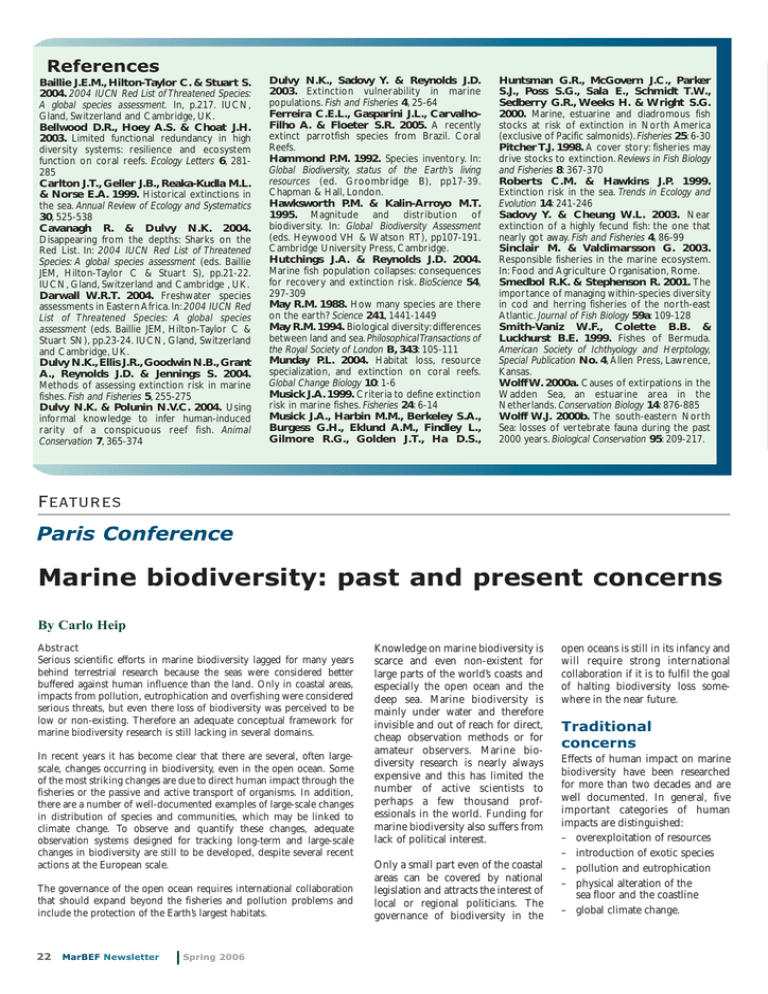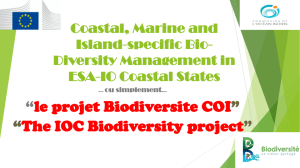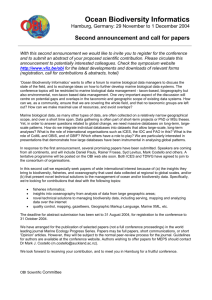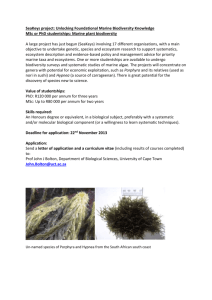References
advertisement

References Baillie J.E.M., Hilton-Taylor C. & Stuart S. 2004. 2004 IUCN Red List of Threatened Species: A global species assessment. In, p.217. IUCN, Gland, Switzerland and Cambridge, UK. Bellwood D.R., Hoey A.S. & Choat J.H. 2003. Limited functional redundancy in high diversity systems: resilience and ecosystem function on coral reefs. Ecology Letters 6, 281285 Carlton J.T., Geller J.B., Reaka-Kudla M.L. & Norse E.A. 1999. Historical extinctions in the sea. Annual Review of Ecology and Systematics 30, 525-538 Cavanagh R. & Dulvy N.K. 2004. Disappearing from the depths: Sharks on the Red List. In: 2004 IUCN Red List of Threatened Species: A global species assessment (eds. Baillie JEM, Hilton-Taylor C & Stuart S), pp.21-22. IUCN, Gland, Switzerland and Cambridge , UK. Darwall W.R.T. 2004. Freshwater species assessments in Eastern Africa. In: 2004 IUCN Red List of Threatened Species: A global species assessment (eds. Baillie JEM, Hilton-Taylor C & Stuart SN), pp.23-24. IUCN, Gland, Switzerland and Cambridge, UK. Dulvy N.K., Ellis J.R., Goodwin N.B., Grant A., Reynolds J.D. & Jennings S. 2004. Methods of assessing extinction risk in marine fishes. Fish and Fisheries 5, 255-275 Dulvy N.K. & Polunin N.V.C. 2004. Using informal knowledge to infer human-induced rarity of a conspicuous reef fish. Animal Conservation 7, 365-374 Dulvy N.K., Sadovy Y. & Reynolds J.D. 2003. Extinction vulnerability in marine populations. Fish and Fisheries 4, 25-64 Ferreira C.E.L., Gasparini J.L., CarvalhoFilho A. & Floeter S.R. 2005. A recently extinct parrotfish species from Brazil. Coral Reefs. Hammond P.M. 1992. Species inventory. In: Global Biodiversity, status of the Earth’s living resources (ed. Groombridge B), pp17-39. Chapman & Hall, London. Hawksworth P.M. & Kalin-Arroyo M.T. 1995. Magnitude and distribution of biodiversity. In: Global Biodiversity Assessment (eds. Heywood VH & Watson RT), pp107-191. Cambridge University Press, Cambridge. Hutchings J.A. & Reynolds J.D. 2004. Marine fish population collapses: consequences for recovery and extinction risk. BioScience 54, 297-309 May R.M. 1988. How many species are there on the earth? Science 241, 1441-1449 May R.M. 1994. Biological diversity: differences between land and sea. Philosophical Transactions of the Royal Society of London B, 343: 105-111 Munday P.L. 2004. Habitat loss, resource specialization, and extinction on coral reefs. Global Change Biology 10: 1-6 Musick J.A. 1999. Criteria to define extinction risk in marine fishes. Fisheries 24: 6-14 Musick J.A., Harbin M.M., Berkeley S.A., Burgess G.H., Eklund A.M., Findley L., Gilmore R.G., Golden J.T., Ha D.S., Huntsman G.R., McGovern J.C., Parker S.J., Poss S.G., Sala E., Schmidt T.W., Sedberry G.R., Weeks H. & Wright S.G. 2000. Marine, estuarine and diadromous fish stocks at risk of extinction in North America (exclusive of Pacific salmonids). Fisheries 25: 6-30 Pitcher T.J. 1998. A cover story: fisheries may drive stocks to extinction. Reviews in Fish Biology and Fisheries 8: 367-370 Roberts C.M. & Hawkins J.P. 1999. Extinction risk in the sea. Trends in Ecology and Evolution 14: 241-246 Sadovy Y. & Cheung W.L. 2003. Near extinction of a highly fecund fish: the one that nearly got away. Fish and Fisheries 4, 86-99 Sinclair M. & Valdimarsson G. 2003. Responsible fisheries in the marine ecosystem. In: Food and Agriculture Organisation, Rome. Smedbol R.K. & Stephenson R. 2001. The importance of managing within-species diversity in cod and herring fisheries of the north-east Atlantic. Journal of Fish Biology 59a: 109-128 Smith-Vaniz W.F., Colette B.B. & Luckhurst B.E. 1999. Fishes of Bermuda. American Society of Ichthyology and Herptology, Special Publication No. 4, Allen Press, Lawrence, Kansas. Wolff W. 2000a. Causes of extirpations in the Wadden Sea, an estuarine area in the Netherlands. Conservation Biology 14: 876-885 Wolff W.J. 2000b. The south-eastern North Sea: losses of vertebrate fauna during the past 2000 years. Biological Conservation 95: 209-217. Features Paris Conference Marine biodiversity: past and present concerns By Carlo Heip Abstract Serious scientific efforts in marine biodiversity lagged for many years behind terrestrial research because the seas were considered better buffered against human influence than the land. Only in coastal areas, impacts from pollution, eutrophication and overfishing were considered serious threats, but even there loss of biodiversity was perceived to be low or non-existing. Therefore an adequate conceptual framework for marine biodiversity research is still lacking in several domains. In recent years it has become clear that there are several, often largescale, changes occurring in biodiversity, even in the open ocean. Some of the most striking changes are due to direct human impact through the fisheries or the passive and active transport of organisms. In addition, there are a number of well-documented examples of large-scale changes in distribution of species and communities, which may be linked to climate change. To observe and quantify these changes, adequate observation systems designed for tracking long-term and large-scale changes in biodiversity are still to be developed, despite several recent actions at the European scale. The governance of the open ocean requires international collaboration that should expand beyond the fisheries and pollution problems and include the protection of the Earth’s largest habitats. 22 MarBEF Newsletter Spring 2006 Knowledge on marine biodiversity is scarce and even non-existent for large parts of the world’s coasts and especially the open ocean and the deep sea. Marine biodiversity is mainly under water and therefore invisible and out of reach for direct, cheap observation methods or for amateur observers. Marine biodiversity research is nearly always expensive and this has limited the number of active scientists to perhaps a few thousand professionals in the world. Funding for marine biodiversity also suffers from lack of political interest. Only a small part even of the coastal areas can be covered by national legislation and attracts the interest of local or regional politicians. The governance of biodiversity in the open oceans is still in its infancy and will require strong international collaboration if it is to fulfil the goal of halting biodiversity loss somewhere in the near future. Traditional concerns Effects of human impact on marine biodiversity have been researched for more than two decades and are well documented. In general, five important categories of human impacts are distinguished: – overexploitation of resources – introduction of exotic species – pollution and eutrophication – physical alteration of the sea floor and the coastline – global climate change. Besides direct exploitation, a number of other human-induced changes have occurred: changes in climate and water circulation, human constructions removing or creating physical barriers (canals, dams), maritime and air transport and drifting objects (plastics, nets, etc) and deliberate releases of organisms by humans. It is not always clear what the effects of such indirect impacts are, but changing communities and food webs have been documented over the last decades, especially where their change has provided a threat to human exploitation of marine systems. These include changes in dominance in systems from shellfish to worms, reported from long-term time-series of shallow marine benthos as in the Wadden Sea, from fish to jellyfish as in the Adriatic and Black Sea, and increasingly from macro- to microbes, as in the now over a hundred so-called dead zones where anaerobic conditions prevent animals from being present. Goods and services The changes described above are bound to change the goods delivered by marine ecosystems, including food from fisheries and aquaculture (half the protein of the Philippines and Japan), chemical products (pharmaceuticals, anti-cancer drugs, anti-fouling agents, etc), coastal protection (reefs, mangroves, salt marshes) and recreation (tourism being the most important global employer with industries depending on healthy and diverse marine ecosystems). Services provided by marine ecosystems include primary production, carbon sequestration, oxidation and mineralisation and detoxification of waste. Marine organisms play crucial roles in many biogeochemical processes that sustain the biosphere. The rate and efficiency of any of the processes that marine organisms mediate, as well as the range of goods and services that they provide, are determined by interactions Present concerns We are at present unable to predict the consequences of changing ecosystem functioning or the loss of biodiversity resulting from environmental change in ecological, economic or societal terms. Most ecological theories are based on experience from terrestrial ecosystems, but marine biodiversity does not necessarily comply with terrestrial paradigms. Our understanding of the role and regulation of marine biodiversity lags far behind that of terrestrial biodiversity, to such an extent that we do not have enough scientific information to underpin management issues such as conservation and the sustainable use of marine resources. There is no way yet to include marine biodiversity adequately in general ecosystem models, and the views of marine ecosystems as being either regulated top-down (fisheries) or bottom-up (biogeochemistry) are still widely different and have not been reconciled. The present objective of managing fisheries in an ecosystem context will have to find ways to bridge this gap. One of the major present concerns in marine biodiversity research is that quantification and valorisation of goods and especially services from marine biodiversity is not easy, and perhaps not a fruitful research objective for the future. Most goods are provided by macroorganisms whereas most of the functioning of marine systems, and therefore the services, is dominated by microbes. Microbes are still extremely poorly known, and traditional ecology and, even more, fisheries ecology, only deals with a very restricted part of marine biodiversity. Conservation of marine biodiversity will require an important outreach effort from the scientific community and willingness from politicians to develop the national, EU and international agreements and conventions on which it should be based. This will not happen unless the general public gets some feel for marine biodiversity, its importance for the global ecology of the planet and also its uniqueness and beauty, and understand that neither coastal areas nor the open oceans are resistant to human impacts and that therefore a serious risk exists that some of the most valued species and habitats will disappear from the globe if nothing is done. Thierry Perez between organisms, and between organisms and their environment, and therefore by biodiversity. The effect of biodiversity on ecosystem functioning has become a major focus in ecology. The insurance hypothesis is a fundamental principle for understanding the long-term effects of biodiversity on ecosystem processes. High biodiversity insures ecosystems against decline in functioning because the more species an ecosystem carries, the greater the guarantee that some species will maintain functioning in the absence of others. The strength of this insurance, and the relationship between biodiversity and ecosystem functioning in general, has not been quantified in the marine realm yet. ' The impacts of these categories and their combinations are relatively well known. They can lead to species extinction locally, but global loss of species is still rare in the marine environment. However, although the number of well-documented cases of extinction is low, it has also clearly been established that a large number of marine species has undergone severe loss in numbers worldwide, especially top marine predators and grazers such as sharks and rays, pelagic and benthic large fish species (tuna, cod), marine turtles and some birds and marine mammals (dolphins, whales, seals). Besides species’ numbers changing due to direct human exploitation, marine habitats are increasingly impacted and disappearing locally with the species that inhabit them. These include shallow-water habitats such as intertidal rocky shore areas and sandy beaches, mangroves in the tropics, shallow subtidal seagrass meadows, sediments in heavily trawled areas and shallow-water corals and reefs in general, and increasingly deep-water habitats such as sea-mounts and deep, coldwater coral reefs as well. Corallium rubrum. Conclusions biodiversity is very unlike • Marine terrestrial biodiversity: a strange and • • • • • • • beautiful world with many creatures that have nothing in common with what we know from our day-to-day experience as terrestrial mammals. Many marine populations and habitats have a wide distribution, and marine extinction may be rare and therefore not an item of concern. Still, marine biodiversity is changing rapidly in coastal regions and the open oceans alike. Much of that change is anthropogenic (fisheries, climate) and may be irreversible, because we can do nothing about it. The consequences of such changes are difficult to evaluate and their observation requires new systems and networks. There is no general theoretical framework for marine biodiversity yet and no adequate ecological modelling approach. Large areas of the open ocean are not under national jurisdiction or in fact any jurisdiction. The seas are free for all to use. Marine biodiversity science to address the problems adequately needs to have access to and communication with governments and international institutions (EU, EEA, CBD, etc) to have effect on policies in such areas at the required scales. Marine biodiversity science needs to be multidisciplinary and internationally organis-ed to facilitate the interactions: MARS, ICES, CIESM, EU Networks of Excellence such as MarBEF (Marine Biodiversity and Ecosystem Functioning) and Euroceans. Efforts from the scientific community are required to make the general public understand what is at stake. Carlo Heip Netherlands Institute of Ecology The Netherlands Email: c.heip@nioo.knaw.nl Spring 2006 MarBEF Newsletter 23




